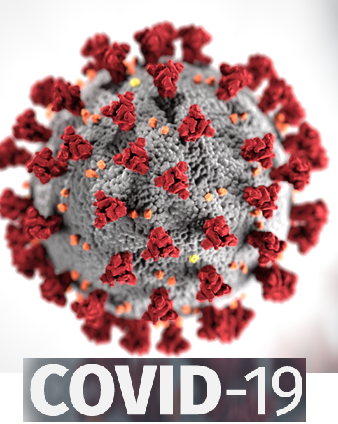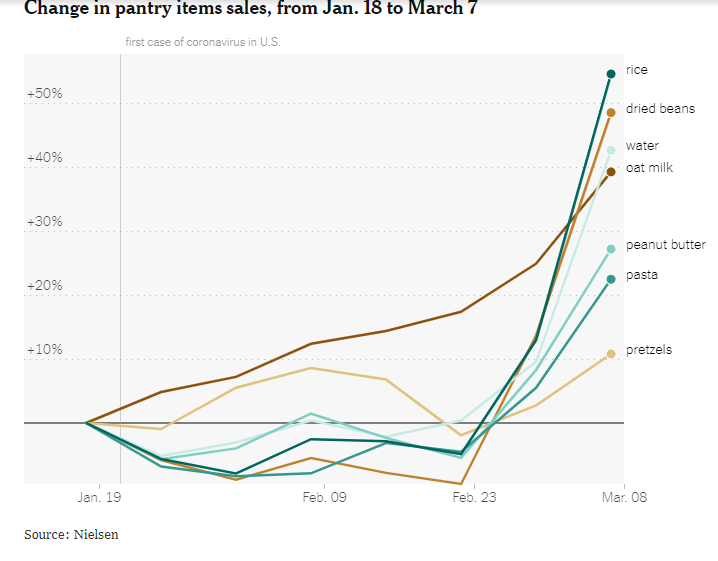Can the food industry be a predictive model and provide vision to the economical recovery from the Corona pandemic in the US and the world
By Gideon Eden, PhD
Abstract
 The food industry found itself in a unique dire situation when the corona pandemic took place and spread globally. Like any other industry, its workers have been exposed to the virus, consequentially changing the manufacturing dynamics of food production and supply. Unlike many other industries, the food industry did not have the “luxury” of closing the plants, let its workers go home and pause operations, even temporarily. Out of necessity operations have been continued, and it seems that food supplies have not been changed dramatically, at least in the US. While this situation can be negatively altered in the future, it is worthwhile to gather data and learn whether its experience and success of operating under such severe circumstances can help in turning back the economy, by applying their methods and practices, while maintaining optimal safety to its personnel. Can the food industry be the savior?
The food industry found itself in a unique dire situation when the corona pandemic took place and spread globally. Like any other industry, its workers have been exposed to the virus, consequentially changing the manufacturing dynamics of food production and supply. Unlike many other industries, the food industry did not have the “luxury” of closing the plants, let its workers go home and pause operations, even temporarily. Out of necessity operations have been continued, and it seems that food supplies have not been changed dramatically, at least in the US. While this situation can be negatively altered in the future, it is worthwhile to gather data and learn whether its experience and success of operating under such severe circumstances can help in turning back the economy, by applying their methods and practices, while maintaining optimal safety to its personnel. Can the food industry be the savior?
Increase in food demand
The president and CEO of the Consumer Brands Association, Geoff Freeman, told Food Dive (https://www.fooddive.com/news/food-manufacturing-will-stay-healthy-during-coronavirus-trade-groups-say/574655/) that during the last few weeks food consumption has been higher than any previous holiday or sporting event. Some companies have seen their orders increase by 700% as Americans shopped for food for consumption and accumulation at home while sheltering at home in order to protect themselves and slow the virus’ transmission. Consumers were hoarding foods, with an emphasis on shelf-stable foods and snacks. During the week ending March 14 sales of dry beans were up 230.5%, canned black beans 150.4%, and soups by 126.6% compared to the preceding year. Snacks and other indulgences also saw an increase, with sales of potato chips up by 29.6% and ice cream increasing by 23.1%. People are being advised to shelter at home and not go out. This spike in consumer demand necessitates that the food industry workers along the supply chain need to get out of the house and keep working.
The NY Times (https://www.nytimes.com/2020/03/15/business/coronavirus-food-shortages.html) reported that the food supply chain remains unscathed and has been increasing supply to meet the unprecedented stockpiling brought on by the Coronavirus pandemic. However, food suppliers and retailers are struggling to fill the unparalleled demand for canned foods and other durable products. They are fighting the perception that the scary scenes at the grocery store actually reflect a fundamental breakdown.

The Nielsen research (https://www.meatpoultry.com/articles/22767-consumers-buying-habits-shifting-in-response-to-coronavirus) showed an increase in rice sale of 50%, canned meat 40%, and other essentials such as beans, pasta, and bottled water have also spiked. Sales of powdered milk products surged 84% during the last week of February.

Although there seem to be shortages in shops, the National Chicken Council claims that there no disruptions in production. They claim that there are “ample surplus supplies of chicken in cold storage” totaling more than 950 million pounds, according to government data. Still, the fear is there. The more empty shelves people see the more panic-buying ensues, and as a result, more food is out of stock. Orders for hot dogs at Walmart and Costco increased by as much as 300%, meat suppliers say. In response, some hot dog plants have added Saturday and Sunday shifts and have started shipping packages they were storing for Memorial Day cookouts.
The Food business News (https://www.meatpoultry.com/articles/22767-consumers-buying-habits-shifting-in-response-to-coronavirus) reports that consumers are avoiding fresh produce, dairy, and meat because they are worried about people touching these products, the Nielsen report says.
The UN warns of global food shortage that can be caused by Coronavirus measures
The United Nations Food and Agriculture Organization (https://thehill.com/policy/international/489783-united-nations-warns-of-global-food-shortage-caused-by-coronavirus) warned of global food shortages caused by measures related to the spread of the novel Coronavirus. Harvests have been good and major crops remain in demand, but a shortage of field workers brought on by the pandemic and a move towards protectionism, tariffs and export bans, could lead to problems in the coming weeks.
Some countries have begun to protect their food supplies by restricting exports. Another measure that could threaten the world’s food supply is that nations have issued stay-at-home orders at varying levels of enforcement. If agriculture workers are unable to harvest crops, it could cause a lapse in food flow. Countries have yet to implement policies to ensure that food shall keep flowing.
Food and agricultural adjustment
It looks like the food industry in the US is rising to the occasion and promises no shortages of essential foods. Food manufacturers, such as Conagra Brands and Campbell Soup Co., are increasing the production of top-selling items. General Mills announced that it was adjusting its distribution to ensure that its inventory is going where demand is highest.
Many of today’s modernized factories have more automation and equipment; as a result, they are less susceptible to employees being near each other. Today’s factories are not the factories of yesteryear with people crowded around a conveyer belt, and “there is much more social distancing already happening in these facilities.” As a result, it is easier to safely operate these factories.
New procedures are being implemented at food facilities to mitigate the impact of the Coronavirus. Some companies are measuring the employees’ body temperature as they enter the facility, and make them fill a health questioner every day to eliminate sick employees from entering. New training of employees is conducted with an emphasis on proper handwashing and better emphasis on sanitation.
New procedures include additional disinfection at the entrance to the facility, disinfecting the facility and its processing surfaces frequently, and providing protective masks and gloves to all employees.
What can be learned
China is trying to restart its economy, as the number of Coronavirus cases are declining. Workers are going back to work and authorities eased travel restrictions. Slowly the Chinese economy is trying to get back to normal.
In the US, businesses are contemplating how to get back to normal operations once the number of cases starts declining. Ideally, we all hope for a quick recovery of the economy, with public services re-instated. However, the restart of the economy should start with simultaneously starting the operations of the manufacturing facilities. Such facilities should initially be the ones residing in rural areas where there are currently low levels of infections by the Coronavirus. Gaining from the food industry extensive past experience and infrastructure, new procedures and precautions should take place to ensure safe working environment and facilities.

Final Thoughts
Out of necessity the food industry remained highly active during the corona crisis. People generally agree that that has been a wise decision. Today, at April 1 2020, people can imagine what would have happened if supermarkets across the land were closed and could not provide food for even short periods of time. The American society, that in general did not witness massive hunger since the great depression, is devastated by any prospect of food shortage. Consequently, in this case, the decision has been already made, for better or worse.
Second, society has been gaining from the enormous experience and the infrastructure of the food industry which indeed can continue providing the nation’s current needs. Thanks to the contribution of food safety to ensure safe consumer products, safety regulations had been implemented resulting in safer working environments, and consequently, people are heading daily to produce and manufacture in relatively safe plants. While the situation may alter and workers may (and probably will) get sick, most people still agree that we should collectively take that risk.
But what about other industries? Is it better to shut down the economy until the crisis is over? And when is it really over? Can humanity survive such closure for extended periods of time? This is by no means an easy question. Recent complex mathematical models have failed to predict the current status of the global and local pandemic. So how can we ever make an educated decision that will turn things around?
It is not the first time that people have to make such decisions. On the individual level we are making critical decisions many times during our life, especially health-related decisions. For example, elective surgeries, while not treating life-threatening situations, they still dictate our quality of life and our spiritual being. We are told about the risk factors AND THEN WE MAKE AN EDUCATED DECISION. We don’t have time machines to go back and verify that we made the right choice, but we still make these decisions again and again.
With the current pandemic era, we are called to make decisions to life-threatening situations which may have dire consequences if we decide to take or avoid actions. As many things in life, the choice may not be binary. We do have the option to proceed with gradual actions in places where the risk is relatively low and constantly monitor the outcome. It does not prevent from reversing wrong decisions in places in which people still get sick. Special consideration should be applied to automated manufacturing facilities. It can be a highly automated food canning factory that can produce enormous amounts of food that lasts for years, or electronic products manufactured by robots and automated assembly lines. The authors believe that many people will indeed evaluate the risk, look for industries that practice “in work distancing” and return to work, helping themselves and society.
The million dollars question (actually trillion dollars question) is when such approach should be implemented. If this non-binary decision is found to be reasonable, then we believe it should be applied right now. It is a decision that should not undergo any delays. Implementing it tomorrow will not provide any benefit, since the virus will still be with us. Timely decisions should be made constantly when successful and unsuccessful results shall manifest. Monitoring and adjustments should be performed by groups of professionals looking at all relevant aspects simultaneously. Molecular biology scientists, expert physicians, economists and yes, even politicians should provide collective wisdom to the decision-makers.
We shall overcome!

One response to “Can the food industry be a predictive model and provide vision to the economical recovery from the Corona pandemic in the US and the world”
Great Blog!